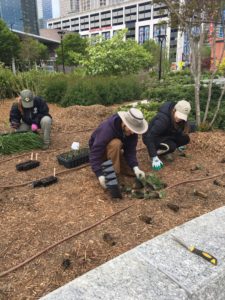Spring has definitely sprung here in Mecklenburg County! As the temperatures get warmer, trees, flowers and plants are blooming and illuminating our parks with magnificent colors (you REALLY should check out Romare Bearden and/or First Ward when you get a chance to see for yourself). But, we know that our parks aren’t the only place where gardens grow. The change from cold to warm may even have YOU inspired to spend time outside and work on your yard.
Let’s face it though, it’s not as simple as just digging a few holes and watering every now and then. There’s a lot that goes into making a garden thrive! Luckily, Park and Rec has a fantastic horticulture team that shed some light on how to help you discover your green thumb.
Essential Gardening Tips:

Park and Rec Horticulturist Kris DeBerry and volunteers from CROWN plant a pollinator garden in First Ward Park.
- Plant native plants. Plants native to our region evolved here, which naturally makes them easier to grow than non-native plants! The Lady Bird Johnson Wildflower Center is a fantastic resource to find detailed information about most plants native to the United States, including which states they grow in.
- Less (water) is more. Don’t even think about overwatering! Certainly, there are differences between how much water is required depending on the plant, but a good rule of thumb is to give your plants water when we go over a week without rain in the summer. Generally speaking, your smaller plants require less water as it is, compared to larger, greener leaves that like wetter soils.
- Protect your plants. Deer, squirrels, moles, voles, cats and dogs are not your garden’s friends! They can wreak havoc on an unprotected garden, especially on small plants. Unless a plant guarantees resistance, you should expect that it will be found and take the necessary steps to protect it until it can fend for itself.
- Consider the sun. Just like plants have their preferences with water, they also have their preferences with sun vs. shade. So, make sure you know what type of environment your plants will thrive in before picking a planting spot. Typically, plants with bigger leaves will require more shade.
- Know your soil. Native plants like our native soils, so little amending is required. But, there are still a few things to know and pay attention to. For example, if you live in a newer home where the soil was graded prior to construction, organic matter needs to be added to bring life back into it. A healthy soil full of earthworms and microscopic organisms equals healthy plants! Another thing – different plants prefer different types of soil (dry vs. wet, for instance). To ensure that you’re planting the right plants in the right places, spend some time exploring your property to discover the soil conditions you’re surrounded by.
Bonus tip:
Soil testing is even free certain times of the year via the North Carolina Department of Agriculture & Consumer Services. Here’s what you’ll need to do to take advantage of it:
- Print the Lawn and Garden Soil Sample form found about halfway down the page.
- Pick up as many sample boxes as you need from the County Cooperative Extension Agency on Armory Drive in Charlotte.
- Mail the samples to the lab in Raleigh. The website has a great presentation on how to collect a sample and interpret the results. The tests are free from April to Thanksgiving. From December through March, there’s a $4/sample box fee.
Whether you’re a first-time gardener or have been planting for years, don’t leave these tips inside. Bring them with you as you get started to see your garden flourish all season long!
